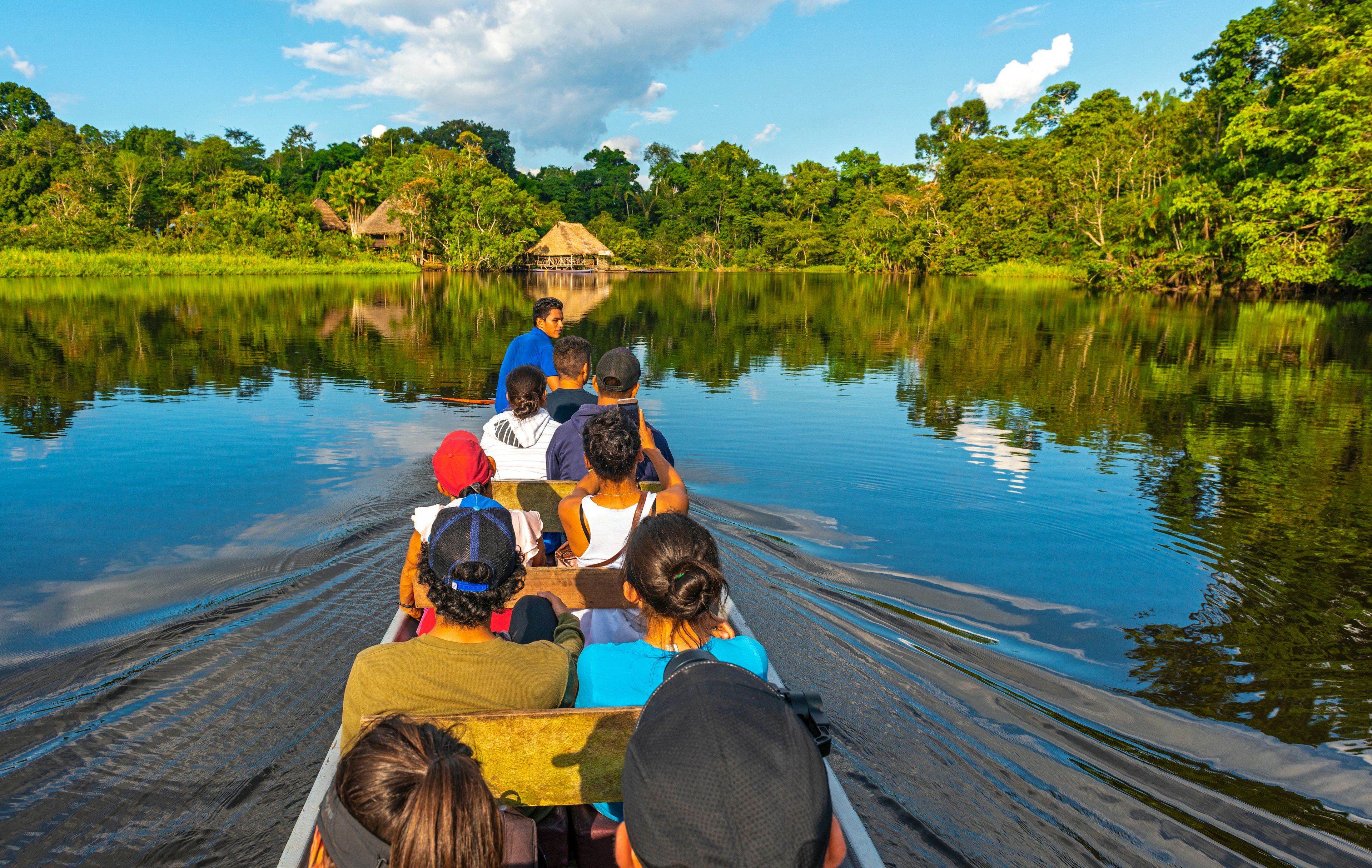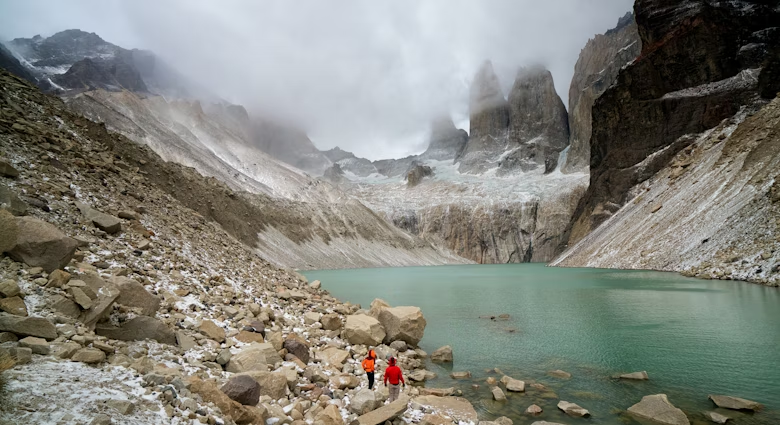

Meeting a jaguar in the Amazon is one of the world's most breathtaking wildlife experiences. Dicky Singh/Getty Images
South America’s surreal landscapes, energetic cities and unmatched natural diversity attract millions of travelers every year. With scenery varying from lush rainforests and rolling grasslands to snow-capped volcanoes and deserts littered with pink flowers, this vast region is a playground for nature enthusiasts and people seeking to explore some of the world's most spectacular ecosystems.
However, biodiversity is just the icing on the cake on a visit to South America. The region's vibrant cultural tapestry and long list of adventure activities receive just as much attention, luring in travelers from around the globe.
But where do you start when South America offers so many endlessly fascinating options? Whether you’re a veteran globetrotter looking for your next big adventure or an occasional traveler looking for a new way to satisfy your wanderlust, chances are there’s a South American country that will suit you to a tee.
To help you narrow down the list, here’s a rundown of the must-visit destinations in South America.

1. Galapagos Islands, Ecuador
Best for wildlife
One-of-a-kind ecosystems, fauna found nowhere else in the world and links to Charles Darwin’s theory of natural selection have all contributed to the Galapagos Islands’ reputation as one of the world's top wildlife destinations. But make no mistake – despite the “touristic hotspot” label and some misconceptions attached to its name, the archipelago remains a vital haven for wildlife protection.
Administered by Ecuador, the major islands of San Cristóbal, Santa Cruz and Floreana, and numerous small islands and surrounding islets, flaunt natural wonders worth witnessing at least once in a lifetime. Volcanic calderas, lava tunnels and pristine beaches are home to endemic species so unique that their evolution continues to be studied and closely monitored nearly two centuries after Darwin visited. Giant tortoises, sea lions, marine iguanas and the only penguin species to live in the northern hemisphere are some of the creatures that thrive in this primeval landscape.
Visiting the archipelago comes with its own set of responsibilities, and costs. However, exploring the untouched coastlines of uninhabited islands and coming face to face with rare wildlife in its natural habitat is an experience hard to replicate in other parts of the globe.
Planning Tip: If you’re hoping to come across specific species during your trip, make sure you pick the right time of year to travel. The seasons for animal sightings vary vastly depending on the species. For instance, the best time to spot blue-footed boobies is from May to August, when they perform their famous courtship dances, while July to November is the best time for whale encounters.

2. Bogotá, Colombia
Best for discovering South America’s dynamic food scene
South Americans will never see eye to eye when it comes to picking which country has the best food, but there’s a growing consensus that Bogotá is home to the region’s most promising culinary scene. With offerings as varied as Colombian haute cuisine, hearty European-inspired dishes prepared with South American ingredients, and dynamic Asian fusion food, the city has something for every taste.
At contemporary restaurants such as Debora, homegrown chefs have reinvented the national cuisine with menus that reflect Colombia’s rich diversity. From costa y río (coast and river) cuisine to the flavors of the campo (countryside), expect treats such as fresh tuna, beef tongue and crispy pork dishes garnished with edible flowers, Andean herbs and cereals, among other highlights.
Meanwhile, La Ventana at Hilton Bogotá delights diners with its “Colombian Corner” where Colombian essentials such as ajíaco (chicken, corn and potato soup), arepas (corn cakes) and empanadas (stuffed pastries) are reimagined with fresh ingredients sourced directly from sustainable gardens.
But Bogota’s charm extends far beyond delicious food and fine eating. The city scores bonus points for its budding cultural scene, gorgeous landscapes and its citizens, who are some of South America's warmest people – regardless of what fellow Colombians might claim!
Planning Tip: Bogotá’s foodie culture isn't limited to restaurants. Spaces such as Casa Creciente, a design hub in the chic Quinta Camacho neighborhood, merge fashion and food, with a curated selection of designer gear and gourmet products, including herbal tea blends, artisanal wines and chocolate from local Colombian brands.
Across town, Mercado de la Tierra Slow Food opens its doors every Sunday, providing a vibrant marketplace for entrepreneurs and producers selling organic veggies and fruits, natural seasonings, cheese, pastries and other "Made in Colombia" delicacies.

3. Uyuni Salt Flat, Bolivia
Best for extreme scenery
Spanning more than 10,582 sq km of the Bolivian Altiplano, the Salar de Uyuni is one of South America’s most extreme landscapes. This surreal area of salt flats was once covered by a large body of water that evaporated, leaving a thick crust of salt behind.
Whether you visit during the rainy season (December to April) to see the flats transform into a natural mirror, or touch down during the dry season (May to November) for a 4WD tour across the hardened salt, the journey is well worth the time investment. Surreal reflections, illusions of perspective and beautiful starry skies create the perfect backdrop for creative photos.
Highlights of the region include the Great Train Graveyard, the largest train graveyard in the world, and cactus-covered Incahuasi (House of the Inca) Island – this eye-catching hummock stands out amidst the expanse of white, but it's only fully accessible during the dry season.
Planning Tip: Located in Southwest Bolivia, the Salar de Uyuni is accessible from both Bolivia and Chile, making it a favorite stopover for tours visiting both countries. If you enjoy rugged terrain, consider booking a tour taking in both Chile's Atacama Desert and the Salar de Uyuni.
Tour operators such as World White Travel organize stopovers in the Eduardo Abaroa Andean Fauna National Reserve, the Desierto de Dalí and a series of lagoons in Bolivia where you can observe flamingos, vicuñas and natural geysers. For a different experience, contact Naya Traveler for tailor-made stargazing itineraries.

4. Fernando de Noronha National Marine Park, Brazil
Best for a relaxing getaway
Basking in the Atlantic Ocean off the coast of Brazil, the Fernando de Noronha archipelago is one of South America's best-hidden jewels. Protected by the government and recognized as a UNESCO World Heritage site, the archipelago is a playground for marine enthusiasts and anyone who craves a relaxing retreat.
Located about 340km off the mainland, this archipelago of 21 islands receives only a limited number of tourists every month, allowing visitors to bask on azure beaches and enjoy the paradisiacal seascapes in relative tranquility. The entry restrictions also minimize the impact of humans on an ecosystem that protects the largest concentration of tropical seabirds in the Western Atlantic, as well as the largest population of resident dolphins on the planet.
Must-see spots in the marine park include Praia do Sancho – which locals insist is the most beautiful beach in the world – and Baía dos Porcos, also known as Dolphin Bay thanks to the congregations of dolphins that gather early every morning. Alongside contemplating the crystal-clear waters and lounging about in gorgeous resorts, popular activities in the archipelago include snorkeling, diving and surfing.
Planning Tip: To support local conservation efforts, travelers are required to pay a national park entry fee of R$373 (roughly US$65), valid for 10 days. Additionally, the Brazilian government charges a daily environmental protection tax of R$97 (around US$17). As visitor numbers are strictly controlled, purchase your entry tickets online in advance.

5. Quito, Ecuador
Best for colonial art and history
It's an old joke, but Quito is widely described as one of South America’s most breathtaking cities, and we mean that literally. Sitting at 2850m above sea level, the Ecuadorian capital will take your breath away, particularly if you fly in from a lower elevation. But the city's architecture and old-school charm, and its location on the slopes of a dormant volcano right on the equator, never fail to amaze travelers.
Part of the appeal lies in the city's seamless combination of Indigenous and Hispanic culture. This cultural crossover is perhaps best exemplified by the famed Quito School of Art – the colonial-era institution that trained Indigenous and mestizo people in painting, wood carving, sculpture and other crafts. Blending European styles such as romanticism, baroque and neoclassicism with Indigenous influences, La Escuela Quiteña quickly became the epicenter of art production in South America.
Its legacy stands the test of time, thanks to the genius of masters such as Manuel Chili “Caspicara,” Bernardo de Legarda and Miguel de Santiago. La Compañia de Jesus, Iglesia y Convento de San Francisco and Monasterio Museo del Carmen Alto are just some of the top names in a long list of religious buildings and museums preserving art from La Escuela Quiteña.
Local Tip: If you’re visiting Quito’s historic center, there's no need for a tour guide. You can see gold-leaf-covered tableaux, polychrome sculptures and Indigenous iconography in many churches open to the general public for free (except at La Compañia de Jésus, where there's an entry fee). And tickets to the museums and historic convents where the greatest art displays are hidden generally include a guided tour.

6. Colchagua Valley, Chile
Best for wine lovers
Conveniently located about 200km from Santiago, the Colchagua Valley is one of Chile’s most recognized wine regions. Famed for its widely lauded, award-winning Cabernet Sauvignon and Syrah wines, Colchagua is an ideal spot for oenophiles focused on tasting specific wines, and the uninitiated, hoping to dip their toes into South American wine culture for the first time.
The grand architecture, historic plantations and high-quality wine at stops such as Casa Silva, Viu Manent and Lapostolle Clos Apalta will enhance any stay in the valley. But not everything in the Colchagua Valley is about wine – once you’ve enjoyed your fill of tastings, horseback tours through the plantations, and winemaking workshops, be ready to go a step further.
As well as viticulture, the region offers spectacular stargazing tours, scenic hiking and biking routes and the opportunity to dive into the culture of the Mapuche, Rapa Nui and Aymara peoples.

7. Machu Picchu, Peru
Best for intrepid travelers
A remarkable piece of ancient engineering, the ruins of Machu Picchu stand testament to the genius of the Inca civilization. Perched at 2430m above sea level and zealously guarded by Huchuy Picchu (Little Mountain) and Huayna Picchu (Young Mountain), the architectural zone covers more than 200 stone structures constructed by the Inca peoples in the 15th century.
Thanks to the mysteries surrounding its construction and the stunning natural landscape, this ancient Inca citadel has become an essential fixture on many South American itineraries. History buffs, adventure-seekers and frankly anyone with a pulse will be thrilled by this famous ruined city in the Andes mountains.
The circuitous route to the ruins brings international travelers from Lima to Cuzco, then the town of Aguas Calientes, where hikers join one of several hiking circuits to reach Machu Picchu. As you traverse the Peruvian Andes by plane, train, road and on foot, you'll be enchanted by the views, the history, the food and the kindness of the Peruvians you meet along the way.
Planning Tip: Daily visitor numbers at Machu Picchu – and the number of visitors allowed on the trekking trails – are capped by the Peruvian government, so plan your trip ahead and book tickets and trekking places in advance through the official Machu Picchu portal or local tour agencies.

8. Amazon Rainforest, Ecuador, Peru, Colombia and Brazil
Best for untamed nature
Don't even think about coming to South America without visiting the Amazon rainforest, one of the most biodiverse places on Earth. Spanning more than 7 million sq km, the world's largest tropical rainforest extends through many countries in South America – the key gateways are Brazil, Colombia, Peru and Ecuador.
Brimming with unique flora and fauna and inhabited by a wide variety of Indigenous cultures – including some of the few uncontacted peoples in the world – the Amazon is a treasure trove for nature lovers and adventure aficionados.
Encounters with unique wildlife such as anacondas, jaguars and macaws make the Amazon rainforest a favorite destination for animal enthusiasts and birdwatchers, and visiting involves throwing yourself into adventurous activities such as hiking, tree-climbing, canoeing and long river journeys by boat.
The human dimension shouldn't be overlooked. Various Indigenous communities welcome travelers into their homes for sustainable and community-based travel experiences, from traditional medicine workshops to river tours in search of rare wildlife.
Planning Tip: Exploring the ecosystems of the Amazon can be a time-consuming and logistically complicated process. If you’re looking for a quick taste, look no further than Ecuador’s Yasuní National Park, where organized tours take travelers to eco-lodges for treks led by Indigenous guides and wildlife spotting trips in dugout canoes.
Explore related stories




 Festivals & Events8 best places in Latin America and the Caribbean to celebrate Carnival
Festivals & Events8 best places in Latin America and the Caribbean to celebrate CarnivalDec 12, 2024 • 6 min read
 ActivitiesWhere to stay in Bogota: the 14 best neighborhoods in the Colombian capital
ActivitiesWhere to stay in Bogota: the 14 best neighborhoods in the Colombian capitalDec 11, 2024 • 11 min read













